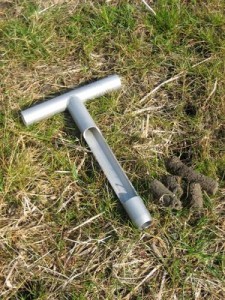Three Good Reasons to Test Your Soil
- Most soils are deficient in one or more nutrients
- Poorly prepared soil leads to poor growth & plant stress
- Results provide vital information for diagnosing problems and avoiding future problems
What Will A Soil Test Tell Me
Ever noticed all those numbers on the front of a bag of fertilizer, 10-20-10 or 34-0-0? How do you know which one you should really be putting on your yard? By getting a soil test you will know what the PH level of you soil is. And if you know the PH of your soil, you will know which bag of fertilizer you need to apply to your landscape.
Those numbers on the front of the bag of fertilizer are NPK numbers. N is for nitrogen which all plants need to promote green growth. P is for Phosphorous of which phosphoric acid is a source and K for potassium of which potash is the source. So, a bag of fertilizer that has 10-20-10 on it is 10% nitrogen, 20% phosphorous and 10% potassium. Should you see a bag with 21-0-0-24, the last number, 24 is the amount of sulfur additive present to help lower soil PH. Usually you will find this information on the back of the bag.
Once you have a soil test done, the extension service will provide you with a report in about 2 weeks. The analysis of your soil will indicated present levels of NPK as well as the PH level (acidity of soil) of your yard (ideal level of PH is 6.5 -6.8).
How Do I get A Good Soil Sample
 I have attached pictures of a variety of different devices for collecting soil samples. Yes, I said samples, meaning 15 to 20 soil cores approx 6 inches deep. As you collect these cores you will want to be sure that when you have finished gathering them all that you have a good representative sample of your yard. Place your cores in a clean plastic bucket and mix them together thoroughly. If the soil is too wet to mix
I have attached pictures of a variety of different devices for collecting soil samples. Yes, I said samples, meaning 15 to 20 soil cores approx 6 inches deep. As you collect these cores you will want to be sure that when you have finished gathering them all that you have a good representative sample of your yard. Place your cores in a clean plastic bucket and mix them together thoroughly. If the soil is too wet to mix  spread the dirt out and let it dry, then mix it. It is recommended that you do not use a metal bucket for contamination reasons.
spread the dirt out and let it dry, then mix it. It is recommended that you do not use a metal bucket for contamination reasons.
Remember, by mixing all your samples together you are going to get a average test result representative of your entire yard and it may not be reflective of areas that are really bad or really good. There is no reason, if you have a wide variety of soils, not to have more than one soil test done. I myself gathered soils representing 3 different areas in my yard. I have an area that water runs through when it rains, so I knew it would have different needs than an area where I had already begun adding organic materials. If I would have done just 1 soil test, I would be over doing the area where I had already begun amending the soil and yet for the area where the water run through, well its needs are completely different.
Now That I have A Bucket Of Dirt, What is the Next Step?
Once you have thoroughly mixed your bucket of soil cores, remove approximately 1 pint of soil and place it in an OSU Pint Soil Sample Bag. These soil sample bags can be gotten at your OSU Extension Office at no charge. There is however a minimal charge for the soil test its self. Once you return the bag back to your local county Extension office they will send it to the OSU Soil, Water and Forage Analytical Laboratory for analysis. Once that analysis is complete, they will also help you interpret the test results. There will make recommendations to you regarding what to add to your soil, how much to add to your soil and when to add it to your soil. So start off the smart way and get a soil test. By doing so you will save time and money and have a beautiful yard!